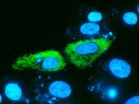(Press-News.org) This press release is available in Spanish.
At the Faculty of Pharmacy of the Basque Public University (UPV/EHU) the Pharmacokinetics, Nanotechnology and Gene Therapy research team is using nanotechnology to develop new formulations that can be applied to drugs and gene therapy.Specifically, they are using nanoparticles todesignsystems for delivering genes and drugs; this helps to get the genes and drugs to the point of action so that they can produce the desired effect.
The research team has shown that lipid nanoparticles, which they have been working on for several years, are ideal for acting as vectors in gene therapy.Gene therapy is a highly promising alternative for diseases that so far have no effective treatment.It consists of delivering a nucleic acid, for example, a therapeutic gene, to modulate the expression of a protein that is found to be altered in a specific disease, thus reversing the biological disorder.
The main obstacle is that the genetic material cannot be formulated in conventional pharmaceutical ways, because it becomes degraded within the organism and cannot perform its function.To overcome this obstacle, viral vectors are normally used and they are able to deliver the therapeutic gene to the cells in which it has to act.However, as Dr Alicia Rodriguez explains, "viral vectors have a great drawback because they have a great potential to develop tumours.That is why there is a lot of interest in developing non-viral vectors, like vectors based on lipid nanoparticles."
"In this respect," adds Dr Rodriguez, "we have for several years been working to develop formulations for treating degenerative retina diseases, diseases for which there is currently no effective curative or palliative treatment and which causes blindness in the patients who in many cases are very young people."The research they have done has borne fruit already, and they have in fact managed to develop a vector capable of making a protein express itself in the eyes of rats after ocular delivery.The work has produced two patents and various papers published in top scientific journals, like Human Gene Therapy.
Aim:to improve drug absorption
Another application of lipid nanoparticles is to develop new formulations to deliver drugs that are not particularly soluble or which are difficult to absorb.Dr Rodriguez explained the problem with these drugs:"40% of the new pharmacologically active molecules are reckoned to be insoluble or not very soluble in water; that prevents many of these potentially active molecules from ever reaching the clinic because of the problems involved in developing a safe, effective formulation."
The Faculty of Pharmacy's research team has shown that the strategy of encapsulating drugs of this type in lipid nanoparticles is effective:"They are spheres made of lipids and they have very small particleswhich encase the drug.That way, the absorption of the drug given orally can be increased," points out Dr Rodriguez.
Part of the research was done in collaboration with the research team led by DrVéroniquePréat, of the Catholic University of Louvain in Belgium.There they studied the capacity of the nanoparticles to pass through the intestinal barrier and therefore increase the permeability of the drug.The results of this work have been published in the Journal of Controlled Release, a leading journal within the specialty.
Furthermore, while considerable advances have been made in both areas (vectors for gene therapy and improvement in insoluble drug absorption), the researchers in the Pharmacokinetics, Nanotechnology and Gene Therapy team are working in a third area linked to hepatitis C in which they also hope to achieve positive results.
INFORMATION:
Researchers show that lipid nanoparticles are ideal for delivering genes and drugs
UPV/EHU-University of the Basque Country researchers are using nanotechnology for therapeutic purposes
2013-02-28
ELSE PRESS RELEASES FROM THIS DATE:
Creating your own animated 3D characters and scenes for the web
2013-02-28
It could be a grotto. Light is glowing up from below and gives the moving waves a glance of an opal under the sunlight. "This computer graphic was written with our new description language by a schoolboy in not more than two hours after a briefly reading of the instructions", explains Felix Klein, doctoral candidate at the chair of Computer Graphics at Saarland University. As Klein is moving three slide switches with the mouse which are placed under the wave graphic on the display, the water is transforming. Now, the waves are spreading circularly from the center point, ...
Mutation altering stability of surface molecule in acid enables H5N1 infection of mammals
2013-02-28
A single mutation in the H5N1 avian influenza virus that affects the pH at which the hemagglutinin surface protein is activated simultaneously reduces its capacity to infect ducks and enhances its capacity to grow in mice according to research published ahead of print today in the Journal of Virology.
"Knowing the factors and markers that govern the efficient growth of a virus in one host species, tissue, or cell culture versus another is of fundamental importance in viral infectious disease," says Charles J. Russell of St. Jude Children's Research Hospital, Memphis, ...
Cell movement explained by molecular recycling
2013-02-28
VIDEO:
This shows fibroblast cells using integrins to migrate through tissue.
Click here for more information.
Scientists at The University of Manchester have identified the method by which cells control the recycling of molecules, a process that is essential for them to move. The discovery provides researchers with a better understanding of how our bodies heal wounds.
Working under Professor Martin Humphries, the Dean of the Faculty of Life Sciences, Dr Mark Morgan and ...
Trackable drug-filled nanoparticles -- a potential weapon against cancer
2013-02-28
Tiny particles filled with a drug could be a new tool for treating cancer in the future. A new study published by Swedish scientists in Particle & Particle Systems Characterization shows how such nanoparticles can be combined to secure the effective delivery of cancer drugs to tumour cells – and how they can be given properties to make them visible in MR scanners and thus rendered trackable.
The team, which consisted of scientists from Karolinska Institutet (KI) and the Royal Institute of Technology (KTH) in Stockholm, and from Chalmers University of Technology in Gothenburg, ...
Study finds diabetes does not increase risk of total knee surgical complications
2013-02-28
PASADENA, Calif., Feb. 27, 2013 – Patients with diabetes who undergo total knee replacement surgery do not have increased risk of surgical complications compared to those patients without diabetes, according to a Kaiser Permanente study published today in The Journal of Bone and Joint Surgery.
Researchers studied the electronic health records of more than 40,000 patients who had a first-time knee replacement from January 1, 2001 through December 31, 2009. Of the patients studied, 12.5 percent had controlled diabetes, 6.2 percent had uncontrolled diabetes and 81.3 percent ...
About 15 percent of patients with Wolfram syndrome do not meet current diagnostic criteria
2013-02-28
Researchers at IDIBELL and CIBERER Virginia Nunes and Miguel López de Heredia have collected data from 400 patients with Wolfram syndrome published worldwide in the last fifteen years to better understand the natural history of disease. The findings lead them to propose a revision of the diagnostic criteria of the disease because 15% of paediatric patients escape from diagnosis.
The results of this review have been published this week in the online edition of the journal Genetics in Medicine to coincide with the World Day of rare diseases, on February 28th. These rare ...
Wars on editing Wikipedia articles, uncovered
2013-02-28
CSIC researcher Maxi San Miguel, director of the Institute for Cross-Disciplinary Physics and Complex Systems (IFISC), a joint research Institute of CSIC and the University of the Balearic Islands, explains: "We say there is a conflict when there is an unusual high number of editing and corrections in articles related to some topic or personage on which there are very divergent or polarised opinions. Our model identifies the different types of behaviours according to two main parameters: the reposition rate of editors as time goes by; and the level of tolerance, that is, ...
Toxic oceans may have delayed spread of complex life
2013-02-28
A new model suggests that inhospitable hydrodgen-sulphide rich waters could have delayed the spread of complex life forms in ancient oceans. The research, published online this week in the journal Nature Communications, considers the composition of the oceans 550-700 million years ago and shows that oxygen-poor toxic conditions, which may have delayed the establishment of complex life, were controlled by the biological availability of nitrogen.
In contrast to modern oceans, data from ancient rocks indicates that the deep oceans of the early Earth contained little oxygen, ...
Closer personal relationships could help teens overcome learning disabilities
2013-02-28
Tel Aviv — In addition to struggling in school, many learning disabled children are known to face social and emotional challenges including depression, anxiety, and isolation. Often beginning early in childhood, they become more pronounced during adolescence, an emotionally turbulent time.
For these youngsters, more positive relationships with the significant adults in their lives — including parents and teachers — can improve learning and "socioemotional" experiences, says Dr. Michal Al-Yagon of Tel Aviv University's Jaime and Joan Constantiner School of Education. In ...
Improving climate protection in the agricultural sector
2013-02-28
The study(*) has enabled scientists to develop a new model that will allow agricultural landholders to determine and improve their climate balance.
As part of the study, scientists investigated 40 organic and 40 conventional agricultural holdings across Germany's four agricultural regions. They focused exclusively on crop and dairy farms. The scientists recorded all relevant climate gas streams during the entire production process, including methane, nitrous oxide and carbon dioxide. In the case of dairy farms, they also factored in the purchase of soybean meal from ...
LAST 30 PRESS RELEASES:
Jeonbuk National University study shows positive parenting can protect adolescents against self-harm
Surface-engineered ZnO nanocrystals to tackle perfluoroalkyl substance contamination
This new understanding of T cell receptors may improve cancer immunotherapies
A new fossil face sheds light on early migrations of ancient human ancestor
A new immunotherapy approach could work for many types of cancer
A new way to diagnose deadly lung infections and save lives
40 percent of MRI signals do not correspond to actual brain activity
How brain-inspired algorithms could drive down AI energy costs
Gum disease may be linked to plaque buildup in arteries, higher risk of major CVD events
Contrails are a major driver of aviation’s climate impact
Structure of dopamine-releasing neurons relates to the type of circuits they form for smell-processing
Reducing social isolation protects the brain in later life
Keeping the heart healthy increases longevity even after cancer
Young adults commonly mix cannabis with nicotine and tobacco
Comprehensive review illuminates tau protein's dual nature in brain health, disease, and emerging psychiatric connections
Book prepares K-12 leaders for the next public health crisis
Storms in the Southern Ocean mitigates global warming
Seals on the move: Research reveals key data for offshore development and international ecology
Sports injuries sustained during your period might be more severe
World's first successful 2 Tbit/s free-space optical communication using small optical terminals mountable on satellites and HAPS
Can intimate relationships affect your heart? New study says ‘yes’
Scalable and healable gradient textiles for multi‑scenario radiative cooling via bicomponent blow spinning
Research shows informed traders never let a good climate crisis go to waste
Intelligent XGBoost framework enhances asphalt pavement skid resistance assessment
Dual-function biomaterials for postoperative osteosarcoma: Tumor suppression and bone regeneration
New framework reveals where transport emissions concentrate in Singapore
NTP-enhanced lattice oxygen activation in Ce-Co catalysts for low-temperature soot combustion
Synergistic interface engineering in Cu-Zn-Ce catalysts for efficient CO2 hydrogenation to methanol
COVID-19 leaves a lasting mark on the human brain
Scientists use ultrasound to soften and treat cancer tumors without damaging healthy tissue
[Press-News.org] Researchers show that lipid nanoparticles are ideal for delivering genes and drugsUPV/EHU-University of the Basque Country researchers are using nanotechnology for therapeutic purposes



